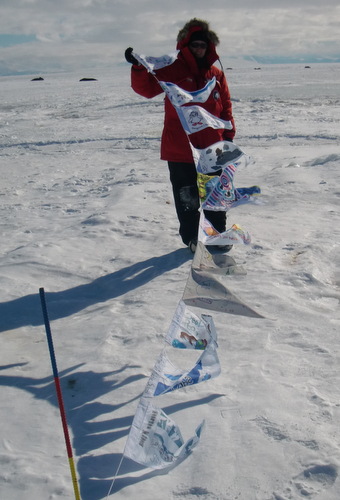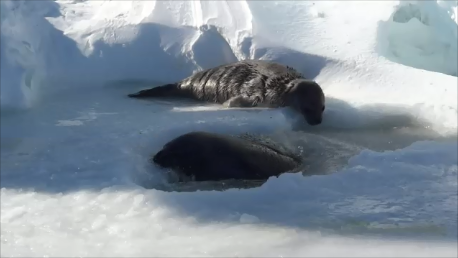
This journal brought to you by...
- Mr. Brent Angelo’s 4th grade students at Chillicothe Elementary in Chillicothe, Illinois
- Ms. Pickering’s 4th grade students at Visitation Catholic School in Kewanee, Illinois
- Mrs. Kelly Richards 1st grade students at St. Louis School in Princeton, Illinois
- Ms. Catherine Hammons 6th grade students at Lausanne Collegiate School
- Hickory Hill Community Center - Ms. Margaret Fluckers 2nd graders
- Seton Middle School’s 6th grade 1st period class in Moline, Illinois
- Benjamin Payson in 6th grade at White Station Middle
- Angelyna Nevi in 5th grade at Immanuel Lutheran School
- Mr. John Trego’s 6th grade class at Mirror Lake Middle School
- Dolphin Thalhauser’s 6th grade class at Mirror Lake Middle School
- Houston Middle 7th Grade Students from the following classes:
- Jean Provine
- Charlotte Frazier
- Jeanette Taylor
Weddell Seal Pups
We are always looking for new Weddell moms and their pups. Although Weddell seals live in a remote environment, they are easy to spot for several reasons. Can you think of what they are?

- They ‘haul out’ on the ice, which makes them easy to spot against the snow-white background.
- Weddell seals are very friendly, easygoing and don’t hide from our research team.
- They are philopatric, which means that they return to their birthplace to give birth to their own pups.
Pupping season peaks in October and November during the Antarctic spring. Remember, the seasons are opposite from the seasons in the U.S. because of Earth’s tilt. Mating occurs almost immediately after pupping season.
Weddell infancy
These pups are so cute! Pictures really don’t do them justice. They look so sweet and innocent – just like human babies. But they are actually quite different from human babies. If you’ve been following my journals, you already know just how extreme their environment is. They live further south than any other mammal, where 20°F is considered warm and wind has been known to blow up to 199 mph!

You might also know that Weddell seals are known for their thick blubber layer, which keeps them warm, but pups are not born with that! Before they are born, they gestate, or grow in their mother’s womb for 9-10 months in the warmest place in Antarctica – inside their moms! A mother’s body temperature stays close to 100°F, so no blubber is needed until they enter the world…on a sheet of ice! Does that sound like a welcoming arrival? These hardy mammals were made for this. Let’s take a look at just how their infant bodies are specially adapted for this kind of start to life.
Pup fur

Check out the difference between this mom’s fur and her pup’s fur. What can you see?
The mom has very sleek, silvery fur. The pup, on the other hand, has fluffy, brown fur. This is called lanugo. Since they barely have any blubber when they are born, they rely on their lanugo coat to keep them warm. This coat of fur is soft and fluffy (and awfully cute!) for a reason. Can you think of a reason? Can you think of any other animals that keep soft, fluffy layers of fur or feathers close to their skin? Ducks, geese, penguins and other birds have downy feathers underneath all of their other feathers, and we wear coats filled with soft, fluffy materials – sometimes even filled with geese down! Fur and feathers like this are excellent insulation, because they trap heat from the animal’s body and keep it close to the skin. But the lanugo isn’t waterproof, and soon, the mom will begin to encourage her pup to get in the water. Pups will start swimming as early as 1-2 weeks old. So how will they stay warm in that icy water?
Mother’s Milk

Pup Development
Now, I don’t remember being a baby, and I’m pretty sure you don’t either. But you might have a baby sister or brother, or you might know someone who does. If you know any babies, you probably know a little bit about their development. What’s that, you say? Have you seen a baby learn to walk? Or start to talk? Have you seen a baby roll over for the first time? Or start to eat solid food? Those are all developmental milestones, and if you ask your parents, you might find photographs of you learning to do all those things!
When I started thinking about pups, I started to wonder if they have any developmental milestones like human babies do. Sure enough, they do! But, of course, they are different from ours.
- A Weddell pup first enters the water with its mother around 2 weeks of age, and its first dives are short and shallow. As they grow, they dive more times each day, and the length and depth of their dives increases. They learn from mom how to forage for food, but they are probably still completely dependent on milk for their diet.

The water looks tempting. Pup about to take a dive. Photo credit: Alex Eilers. By 6 weeks, they are able to dive completely on their own, but their diving will continue to improve over the first 3 years of life. As they grow and get bigger, they will learn to dive longer and deeper, as their blood chemistry and heart rate develop with age.
By 3 years of age, they will be as big as an adult, and their diving skill is like an adult’s.
Between 5 and 7 years of age, they are able to mate and have their own pups!
It’s fascinating to me that they mature so quickly! How do they do it?
It’s all about the brain!
A study completed in 2013 shows that Weddell pups have the largest brains (relative to adult brains) of all baby mammals. Even though their infant bodies are only 6-7% of their adult size, their infant brains are 70% of their adult size. Compare that to human babies, which are born with bodies 5% of their adult size and brains 25% of their adult size.
Those are some brain-boggling numbers! Let’s find out why!
When a human baby is born, she is unable to survive without the help of parents. Her survival is completely dependent on parents to feed and care for her. She can’t even move very far without parents to carry her! Because of this, her brain has time to develop. In fact, it has nearly 18 years to grow and develop, and some of the important development related to making smart decisions doesn’t happen until the teen years!

But it’s actually not just fat she passes to her pup. Her pup’s enormous brain has an equally enormous energy requirement – in the form of glucose, or sugar. The pup’s body needs 30-50 grams of glucose every day, and she gets that in her mother’s milk. I was surprised to discover that 28 grams of that daily sugar dose goes straight to the pup’s brain! And, what’s more, the average Weddell mother provides 39 grams of sugar in her milk each day of nursing. That’s pretty much exactly what the pup needs!
But still, I have to wonder why their brains are so developed at birth…
I dug a little deeper and discovered a few other animals whose infant brains came close to the Weddell’s: zebras and wildebeests! Those two animals have to run with their herd within hours of birth, so they have to be aware of everything around them from the start. And what about Weddell seals? When they take that first dive, they do something only 3 marine mammal species are willing to do: swim under an ice shelf. Just think about how dangerous that is! They have to be able to breathe air, which means they have to be able to find their breathing hole exit in time! Even though the pup does this first with its mom to show the way, it still has to be aware of space in three dimensions. Their brains have to be pretty advanced – nearly as developed as an adult’s – to be able to survive the first weeks of life!
Diving Deeper
Pupping is a lot of work for a seal, and it’s very expensive in terms of energy! But it’s not the only ‘expensive’ task they have to do. Weddell seals molt annually, meaning they shed their fur coat and grow a new shiny one. This process is very expensive! Like our hair, the fur is made of protein, so the mother must have a lot of protein saved for the process. Do you think a seal mom could do these expensive tasks at the same time?
There is no way the mother could nurse a pup AND molt at the same time – she would need a ton of protein! Therefore, the tasks are done separately – nurse then molt! First the mother raises her pup, and then she molts her coat. Sounds like a smart mom to me!
How are these tasks regulated so they don’t happen at the same time? Well, with the exception of one species, all seals are seasonal breeders and share a unique reproductive trait…..
Let’s back up a bit to before the pups are born. Something really cool happens within the Weddell and other seal species during the gestation period (the time spent in the womb between conception and birth). During seal gestation, there is a period known as embryonic diapause, meaning the egg does not immediately implant in the uterus (where it will grow). The egg goes into an inactive state and patiently waits. The egg may wait anywhere from about 4 weeks to 5 months.
What could be a benefit of delaying implantation? It makes sure pups are born at the right time! Seal pups take a set amount of time to develop inside their moms, about 8-10 months. A seal mom has more time between when she can breed and when the conditions are right to have a pup, though—closer to 11 or 12 months. Without delayed implantation, she would have to give birth too early when the weather isn’t right, or when there isn’t a lot of food that her pup could eat after weaning. With delayed implantation, pupping happens at the same time of year every year instead of getting earlier.
Real Life – Seal number 5970

Female Weddell seals usually have their first pup between 5 and 7 years old and will continue having pups almost every year throughout adulthood. One amazing seal, SPENO (Specimen number) 5970, holds the record for the most pups. She is 30 years old and has had 21 pups! This seal was born in 1983 and had her first pup in 1990, at 7 years old. Since then, she had a pup every year except 1993, 2010 and 2011. As a philopatric animal, all of her pups were born in the same spot, Hutton Cliffs, and some of her offspring have returned to the area to have their own pups. One of her daughters is now 22 years old and has had 13 pups of her own. One of these 13 pups has had 5 pups of her own, making those 5 pups the great-grandpups of SPENO 5970!


Comments